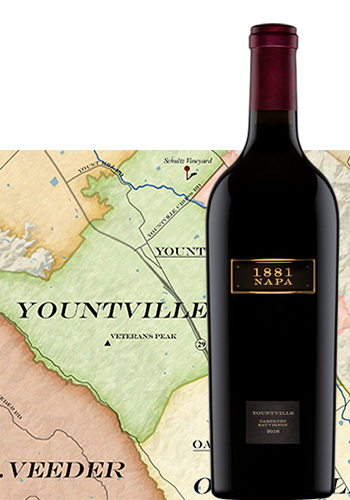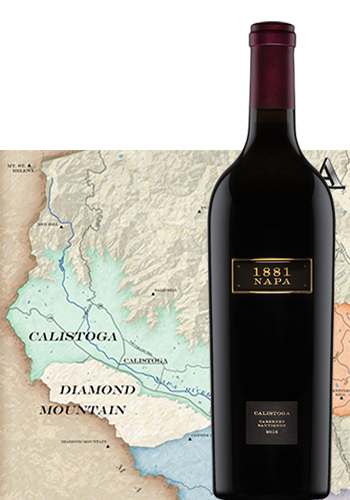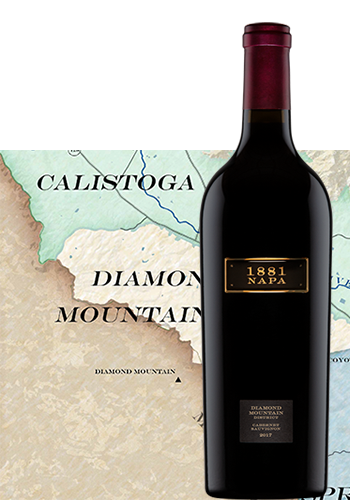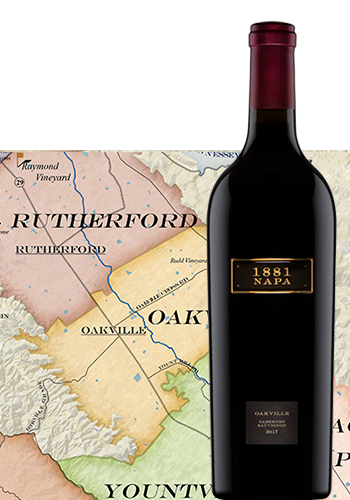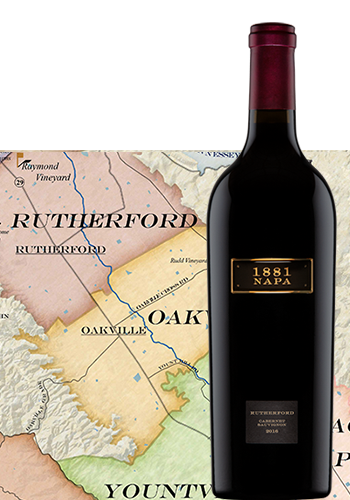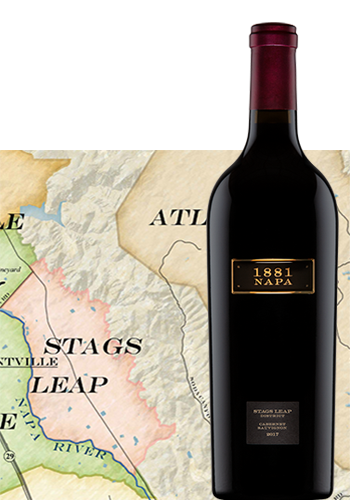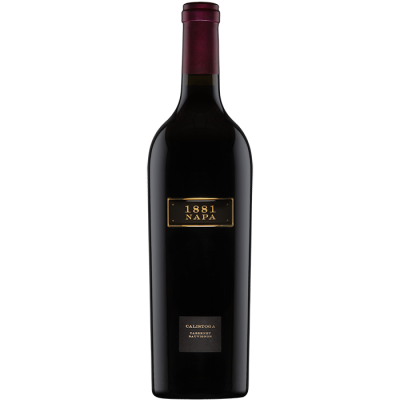1881 NAPA WINES
Napa Valley AVAs
The cherished Napa Valley landscape is planted to 47,000 acres of wine grapes and segmented into 16 distinct AVAs, each lauded for its unique and diverse terroir. Ranging from cool, coastal influences to warmer temperatures, mountainous terrain to valley floor, clay soil to volcanic rock, the Napa Valley American Viticulture Areas are remarkable.
1881 Napa delights in producing appellation-designate bottlings throughout these individual AVAs, providing guests with the opportunity to explore the full range of Cabernet expressions through the region.
Atlas Peak | Calistoga | Carneros | Chiles Valley District | Coombsville | Diamond Mountain District | Howell Mountain
Mount Veeder | Oak Knoll | Oakville | Rutherford | Spring Mountain District | St. Helena | Stags Leap District | Yountville
NAPA AVA - Atlas Peak
Atlas Peak is in the Vaca Mountain Range, separating Napa Valley from the Sacramento Valley to the east. The district's earliest commercial successes were in the resort industry thanks to the presence of therapeutic mineral hot springs. In the 1850s, Soda Springs Resort opened on Atlas Peak, and, two decades later, Atlas Peak Resort was established. Extremely exclusive and posh, both resorts were frequented by wealthy San Franciscans, many of whom had made their fortunes in the Gold Rush. When the resorts closed after Prohibition (1920-1933), much of the land was given over to cattle ranches. Today, the two largest vineyards on Atlas Peak are the Antica Vineyard, a property by the Antinori family of Florence, Italy, and Stagecoach Vineyard, owned by the Gallo family.
Year Established |
1991 |
Acres Planted |
1,609 |
Climate |
Cool, mountain-influenced weather with temperatures about 10 to 15 degrees cooler than the valley floor in summer. Above the fog line, the day-to-night temperature swing is minimal. Summer temperatures rarely rise above 100 degrees F (38 degrees C). |
Elevation & Soils |
Primarily reddish-colored volcanic soils with limited water retention. |
Leading Grapes |
Cabernet Sauvignon, Cabernet Franc, Petit Verdot, Malbec, Merlot |
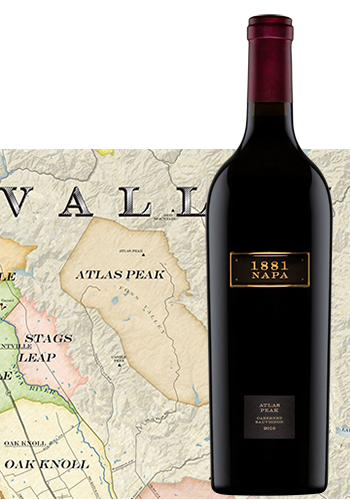

NAPA AVA - Calistoga
Calistoga is home to more than a dozen therapeutic mineral hot springs and spas in addition to numerous wineries. Historically, Native Americans gathered here to use the geothermal waters for detoxification and purification. When he arrived in the area in 1859, Sam Brannan, a practicing Mormon, pioneer, and newsman, named the town "Calistoga," a word concocted from the combination of "California" and "Saratoga." Brannan believed Calistoga would eventually become the western equivalent of Saratoga, New York, a popular resort town known for its mineral hot springs. In 1976, one of Calistoga's most famous estates - Chateau Montelena - took first place for its 1973 Chardonnay in the famous blind tasting known as the Judgment of Paris. That tasting, which pitted renowned French Burgundies and Bordeaux against unknown California wines, is considered the seminal event that put California wine on the international map.
Year Established |
2010 |
Acres Planted |
3,199 |
Climate |
Warm to hot, depending on the time of year. Daytime summer temperatures may peak above 100 degrees F (38 degrees C) and fall to the low 40s degrees F (5 degrees C) at night due to cool afternoon and evening breezes drawn in from the Pacific Ocean. |
Elevation & Soils |
300 to 1,200 feet (92 to 366 meters). Primarily rocky loam on the hillsides; clay-silt soils in the center of the valley. |
Leading Grapes |
Cabernet Sauvignon, Merlot, Zinfandel, Sauvignon Blanc, Petite Sirah, Cabernet Franc |
NAPA AVA - Carneros
"Los Carneros" is Spanish for "the rams," a reference to the sheep ranches that once dominated the rolling hillsides of the region. Carneros is one of California's rare AVAs that span two counties. Approximately half of Carneros is in Napa County and a half in Sonoma County. Carneros' proximity to San Francisco made it a crucial thoroughfare in the middle of the 19th century, especially during the Gold Rush when a stagecoach would traverse the region daily on its way to Sacramento to Petaluma. Several of the first vineyards planted in Carneros were established by Champagne and European sparkling wine producers in search of cool-climate vineyard sites. They include Moët & Chandon, Mumm, Taittinger (which later established Domaine Carneros), and the Spanish Cava producer Freixenet (today part-owner of Gloria Ferrer Caves and Vineyards). Some of the important early clonal research on Pinot Noir in California was conducted in the 1970s by Francis Mohoney, owner of (now defunct) Carneros Creek Winery.
Year Established |
1983 |
Acres Planted |
6,611 |
Climate |
One of the coolest regions in Napa Valley thanks to marine winds blowing inland from nearby San Pablo Bay and through the Petaluma Gap to the west. High temperatures during summer rarely exceed 90 degrees F (32 degrees C). |
Elevation & Soils |
Sea level to 700 feet (0 to 213 meters). Primarily clay and sandy soils on the floor of the region; more loam on the low rolling hillsides. |
Leading Grapes |
Chardonnay, Pinot Noir, Merlot |
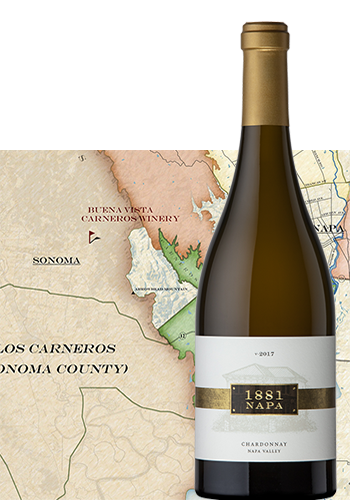

NAPA AVA - Chiles Valley District
Chiles Valley District is home to few wineries but many vineyards. The lack of winery development in the region - and its remoteness from the rest of Napa Valley - has preserved many old vine vineyards, especially those planted with Zinfandel and Cabernet Sauvignon. In 1844, the Mexican government (which then owned what is today California) awarded the land that comprises Chiles Valley to Kentuckian Joseph B. Chiles, an early pioneer and settler, as part of an 8,546-acre land grant called Rancho Catacula. A year later, Chiles built the first American flour mill in northern California.
Year Established |
1999 |
Acres Planted |
881 |
Climate |
Fairly warm summer days (80 to 90 degrees F, 26 to 32 degrees C), but due to higher elevation and summer fog, quite chilly at night (below 50 degrees F, 10 degrees C). Chiles Valley has colder winters and springs, as well as stronger winds than the floor of the Napa Valley proper. As a result, harvest here generally comes later. |
Elevation & Soils |
600 to 1,200 feet (183 to 366 meters). Primarily silty-clay soils of marine origins on the valley floor; stonier hillsides. |
Leading Grapes |
Cabernet Sauvignon, Merlot, Cabernet Franc, Zinfandel, Petit Sirah |
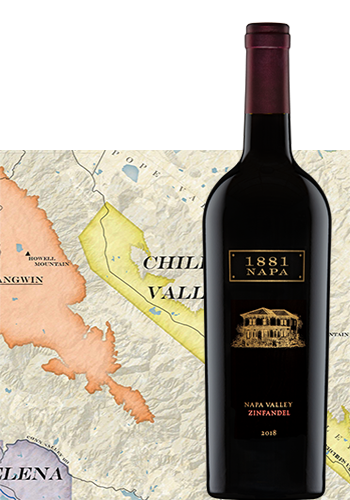

NAPA AVA - Coombsville
In the 1840s, pioneer Nathan Coombs (after which Coombsville is named) received a large piece of the land from fellow pioneer Nicolas Higuera - who had been awarded the area in a land grant from the Mexico government) in a barter. Coombs established a farm on the eastern hills of his land along the Napa River. The farm eventually became the site of the city of Napa, founded in 1847. The first vineyard in Coombsville is thought to have been planted in the 1870s by Henry Hagen, a businessman enticed by the Gold Rush to relocate to northern California. Hagen's winery, called Cedar Knoll, is now the site of Palmax Winery. Like much of Napa Valley, most of Coombsville's vineyards were destroyed by phylloxera in the late 1800s. However, one vineyard remained: the Moore vineyard - site of gnarled, head-trained Zinfandel vines that date back to 1905. The vineyard continues to be owned by the Moore family today. Most of Coombsville's vineyards that survived phylloxera went bankrupt during Prohibition. Over the next several decades, the area was better known for prune orchards than vines.
Year Established |
2011 |
Acres Planted |
1,528 |
Climate |
Coombsville's weather is moderated by its proximity to the San Pablo Bay. During the summer months, daily average high temperatures can be as much as 10 degrees F cooler than most other AVAs in the Napa Valley, and heat spikes here tend to be rarer and less severe. As a result of its generally cooler weather, Coombsville is suitable for growing a wide variety of grape varieties. |
Elevation & Soils |
100 to 1,000 feet (30 to 305 meters). |
Leading Grapes |
Cabernet Sauvignon, Chardonnay, Merlot, Pinot Noir, Syrah |
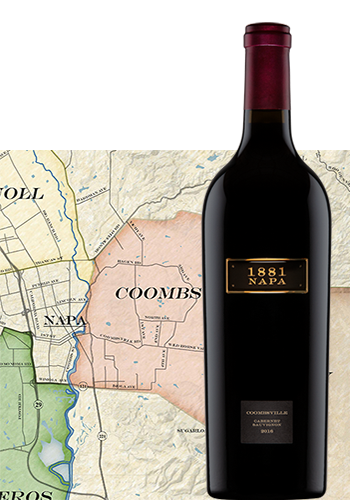

NAPA AVA - Diamond Mountain District
Diamond Mountain is said to have gotten its name from the fine-grained, ash-like soil that contains shards of shiny, reflective volcanic glass that resemble diamonds. The district is home to an estate founded in 1862 by Jacob Schram, a German barber turned grape farmer, who became the first vintner in Napa Valley to plant vineyards in hillsides. He was inspired by the vineyards of his homeland in Germany. Today, Schram's mountainside property is the site of Schramsberg, one of Napa Valley's premier sparkling wine estates. In the 1870s, Chinese laborers dug (by hand) Napa Valley's first hillside caves for aging and storing wine. Renowned winery Diamond Creek, founded in 1968, produced three separate Cabernets based on three distinct soil types on the property. These wines became the earliest articulation of terroir on a micro-level in California. The wine from one of these vineyards, "Lake Vineyard," became the first wine in the Napa Valley to cost $100 a bottle in 1987.
Year Established |
2001 |
Acres Planted |
509 |
Climate |
Due to Diamond Mountain's altitude and topography, its weather is usually moderately warm but not hot, with lower maximum temperatures than the valley floor. During the growing season, daily temperature swings may range from 50 to 95 degrees F (10 to 35 degrees C.) |
Elevation & Soils |
400 and 2,200 feet (122 to 671 meters). Primarily volcanic ash and reddish-colored soils with a fine-grained, gritty texture. |
Leading Grapes |
Cabernet Sauvignon, Cabernet Franc |
NAPA AVA - Howell Mountain
In 1843 George Calvert Yount, a fur trader-turned-vintner and founder of the city of Yountville, received much of Howell Mountain from the Mexican government in a land grant. Howell Mountain was named after Isaac Howell, a rancher who, with his family, arrived on the mountain from the East Coast in 1846 to raise cattle. The first winery to bring critical acclaim to the district was Brun & Chaix in the 1870s, a partnership between Jean Adolph Brun from Bordeaux and Jean Chaix from Provence. In 1877, they planted their first 20 acres with Bordeaux varieties, naming the vineyard "Nouveau Medoc." Brun & Chaix winery, one of the first gravity-flow wineries in the valley, eventually became Ladera. In the modern era, Randy Dunn is widely considered the father of winemaking on Howell Mountain. A Berkeley, California, native who attended U.C. Davis for entomology, Dunn founded Dunn Vineyards in 1979. His Cabernet Sauvignons are widely considered to have some of the longest aging potentials Cabernets in the United States.
Year Established |
1984 |
Acres Planted |
1,164 |
Climate |
Located above the fog line on the eastern side of the valley, Howell Mountain is hotter and drier than most other Napa Valley AVAs and has more hours of sunshine and little to no marine influence. In the summer, the sun setting in the west still shines on vineyards here often until 9 pm. |
Elevation & Soils |
1,400 to 2,600 feet (427 to 793 meters). Primarily shallow volcanic rock, which drains quickly. |
Leading Grapes |
Cabernet Sauvignon, Zinfandel, Merlot, Cabernet Franc, Petit Sirah, Sauvignon Blanc |
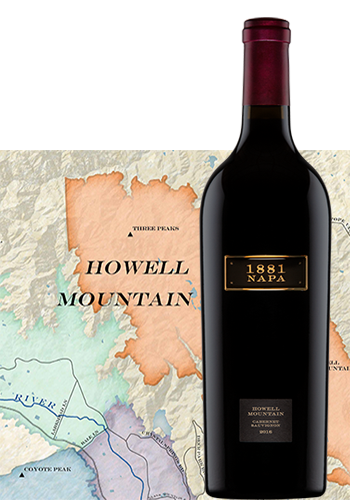

NAPA AVA - Mount Veeder
Mount Veeder is named after a German Presbyterian pastor named Peter Veeder who lived in Napa Valley during the 1860s and was fond of hiking the redwood-covered mountain. In 1864, Mount Veeder's first commercial wine was created by Captain Stelham Wing, who moved to Napa Valley from Ohio with his wife in 1858. Wing's original property is now known as Wing Canyon Vineyard. Mount Veeder's most famous winery, now known as Mayacamas, was founded in 1889 by a German immigrant named John Henry Fisher, who constructed the original stone winery that is still in use. He named the estate Fisher Vineyards and planted Zinfandel vines. Fisher lost his fruit-and-vegetable-preserve packaging company in the destructive 1906 San Francisco earthquake and fire, and he went bankrupt. After the Illinois-Pacific Glass Company purchased the estate, it was renamed Mayacamas (for the mountain range that traverses the region) in 1941 by its then-owner Jack Taylor. Only about 7% of Mount Veeder is planted with vines thanks to the area's rocky, steep, mountainous terrain and dense forests. In fact, although Mount Veeder is Napa Valley's largest sub-appellation, it accounts for less than 2% of wine production. In 1986, Dr. Carole Meredith, a world-famous grapevine geneticist, purchased land on Mount Veeder and ultimately founded the winery Lagier-Meredith. Dr. Meredith is a co-inventory of the process by which a grapevine's DNA can be "typed," thus revealing the variety's genetic parents and history.
Year Established |
1990 |
Acres Planted |
1,257 |
Climate |
Mount Veeder has cool to moderate weather. Most vineyards lie above the fog line, meaning warmer nights and cooler days than on the valley floor. Typical mid-summer high temperatures usually do not exceed 95 degrees F (35 degrees C.) |
Elevation & Soils |
500 to 2,600 feet (152 to 793 meters). Primarily shallow sedimentary rock and sandy soils (derived from an ancient seabed.) |
Leading Grapes |
Cabernet Sauvignon, Chardonnay, Malbec, Merlot, Syrah |
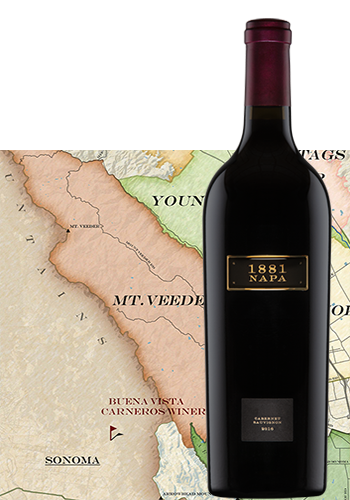

NAPA AVA - Oak Knoll
Oak Knoll District was founded and named by Captain Joseph Osborne, who settled in California during the Gold Rush, moved to Napa Valley, and named his farm Oak Knoll, a reference to the numerous oak trees that speckled the region. In 1852, Osborne planted 3,000 vines in Oak Knoll, for the first time introducing Zinfandel to the area. Just over a decade later in 1863, Osborne was shot and killed by an employee over a pay dispute. His killer, the first man to legally receive the death penalty in Napa County, was hanged for the crime. In 1968, Eugene and Catherine Trefethen restored the historic Eschol Winery (built in 1886) and founded Trefethen Winery. Trefethen's 1976 Chardonnay was judged best in the world in the Gault-Millau World Wine Olympics of 1979.
Year Established |
2004 |
Acres Planted |
4,588 |
Climate |
Oak Knoll District has moderate to cool temperatures, with marine air and fog often remaining until late morning. Late afternoon breezes occur frequently, leading to slightly cooler temperatures here than in the upper valley. Mid-summer temperatures often reach the mid-90s degree F (33 degrees C) and drop to around 50 degrees F (10 degrees C) at night. |
Elevation & Soils |
Sea level to 800 feet (0 to 244 meters). Primarily volcanic soils in the northwest; gravely and clay loam in the south and east. |
Leading Grapes |
Cabernet Sauvignon, Chardonnay, Merlot |
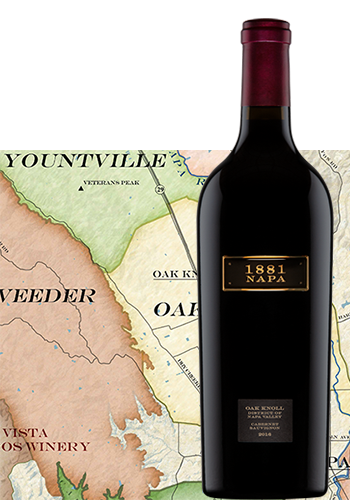

NAPA AVA - Oakville
Some of the most expensive bottles of Napa Valley wine come from Oakville vineyards, including the most expensive wine in the United States, Screaming Eagle. The 2016 Screaming Eagle Cabernet Sauvignon was released to the winery's mailing list at $1,050 a bottle. Oakville Grocery, the oldest continuously operated grocery store in California, was founded in Oakville in 1881. Today, it is owned by Jean-Charles Boisset. After a dispute with his brother Peter Mondavi, Robert Mondavi left the family winery, Charles Krug, and moved a few miles south to Oakville where, in 1966, he opened the Robert Mondavi Winery, the first winery post-Prohibition to be founded in the area. In 1966, Heitz Cellar "Martha's Vineyard" Cabernet Sauvignon became the first vineyard-designated Cabernet in Napa Valley, released at the then-astronomical price of $7 a bottle. Opus One, the first Napa Valley-Bordeaux joint venture, was founded in Oakville in 1978 by Robert Mondavi and Baron Philippe de Rothschild. The deal was reportedly struck in the baron's bedroom with the baron still in his pajamas. The first California wine rated 100 points by Robert M. Parker in the Wine Advocate was also from Oakville: the 1985 Groth Vineyards & Winery "Reserve" Cabernet Sauvignon. Founded in 1995, PlumpJack Winery is co-owned by Gavin Newsom, who became the 40th governor of California in 2019. PlumpJack became the first California winery to bottle an expensive Cabernet Sauvignon under screw cap. The winery's 1997 Cabernet, sealed by screw cap, cost $135 a bottle when it was released.
Year Established |
1993 |
Acres Planted |
3,893 |
Climate |
Oakville, located near the center of the Napa Valley, has warm weather with temperatures that can occasionally rise to 100 degrees F (38 degrees C) or more in the summer. Nighttime temperatures can drop by 50 degrees F (10 degrees C). The east side of the AVA receives warmer afternoon sun. |
Elevation & Soils |
130 to 1,000 feet (40 to 305 meters). Primarily gravelly soils on the western side; volcanic soils on the eastern. |
Leading Grapes |
Cabernet Sauvignon, Cabernet Franc, Merlot, Sauvignon Blanc |
NAPA AVA - Rutherford
Rutherford is named after Thomas Rutherford who, in 1864, married Elizabeth Yount, the granddaughter of Napa Valley’s important founding settler George Calvert Yount. Included in Elizabeth’s dowry was a 1,040-acre parcel of Yount’s nearly 12,000-acre Rancho Caymus land grant that George Yount had received from the Mexican government. That dowry parcel became Rutherford. In 1879, Gustave Niebaum, a Finnish fur-trading sea captain, and the person who did more than any other to establish Rutherford’s reputation, built Inglenook, the Napa Valley’s first palatial chateau-style winery. Niebaum planted Inglenook’s vineyards with noble French varieties, including Cabernet Sauvignon, and was one of the first Napa vintners to estate-bottle his wines. Before this, Napa wines were shipped via cask to San Francisco or the East Coast to be bottled by merchants. Today, Inglenook is owned by the film director Francis Ford Coppola. André Tchelistcheff, who fled Moscow during the Russian Revolution of 1917, emigrated to France where he studied enology, fermentation, and microbiology at the Pasteur Institute. In 1938, in Paris, he met Rutherford vintner Georges de Latour who convinced him to move to Napa Valley to become chief winemaker of Beaulieu Vineyards (BV) which de Latour founded in 1900. Tchelistcheff’s contributions to the California wine industry are legend. He mentored scores of top American winemakers including Robert Mondavi. Tchelistcheff coined the term “Rutherford dust” to describe the distinctive aroma, flavor, and texture of Rutherford Cabernet Sauvignons. In 2009, Jean-Charles Boisset, son of Jean-Claude Boisset, and one of the largest vineyard owners in Burgundy and in France, purchased Raymond Vineyards from Roy Raymond. The Raymonds were related by marriage to another early Napa Valley famil, the Beringers, and Roy Raymond was the winemaker at Beringer from 1933 to 1970. Boisset is also the owner of numerous other California wineries including the historic Buena Vista winery in Sonoma, as well as Oakville’s historic Oakville Grocery and 1881 Napa.
Year Established |
1993 |
Acres Planted |
4,130 |
Climate |
Rutherford, like Oakville, is moderately warm, although it is still marginally influenced by early morning fog. The western side of the AVA is usually cooler than the eastern side. Summer daytime temperatures can occasionally rise to 100 degrees F (38 degrees C) or more, while night temperatures drop significantly. |
Elevation & Soils |
155 to 500 feet (47 to 152 meters). Primarily gravelly sedimentary soils on the western side; deep, volcanic soils on the eastern. |
Leading Grapes |
Cabernet Sauvignon,Sauvignon Blanc, Merlot, Chardonnay |
NAPA AVA - Spring Mountain District
Spring Mountain is not a singular mountain but a series of small peaks west of St. Helena and is so named for the abundant springs and creeks that crosshatch the region. Spring Mountain's waterways supplied St. Helena with water for over 50 years during the town's early history. Napa Valley's first therapeutic hot springs resort - White Sulphur Springs - was founded here in 1848. In 1873, German immigrant Charles Lemme bought 285 acres on Spring Mountain where he planted the first Cabernet Sauvignon on that mountain. He named the property La Perla, or "the pearl." The old winery remains today along with much of its original equipment and horsedrawn carriages and wagons. Immediately below La Perla, and eventually added to it, was the first vineyard planted by Fredrick and Jacob Beringer in 1882. In 1992, Jacob E. Safra, a Swiss investor and chairman of Encyclopedia Brittanica, bought and combined three properties - La Perla, Chateau Chevalier, and Miravalle, a property built in 1885 by a wealthy, exuberant young man named Tiburcio Parrott. Safra called the grand new estate Spring Mountain Vineyards. He continues to own it, including Parrott's original mansion that was used as the setting for the 1980s television series Falcon Crest. (The mansion's famous stained-glass window depicts a parrot, even the television producers insisted on calling it a falcon.)
Year Established |
1993 |
Acres Planted |
1,048 |
Climate |
Spring Mountain has relatively cooler temperatures than the valley floor. Most vineyards sit above the fog line, providing warmer nights and cooler days. |
Elevation & Soils |
600 to 2,600 feet (183 to 793 meters). Primarily weathered sandstone and shale. |
Leading Grapes |
Cabernet Sauvignon, Merlot, Chardonnay |
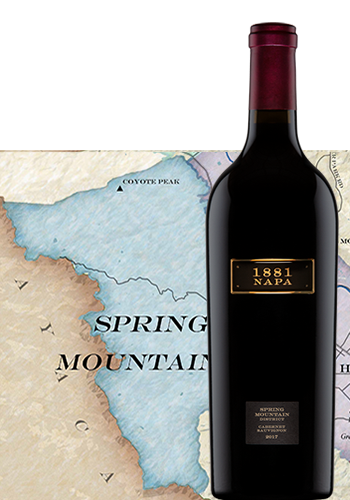

NAPA AVA - St. Helena
Prussian immigrant and Napa Valley pioneer Charles Krug settled in the St. Helena area in the early 1850s and established himself as the first commercial winemaker in the region. He also built California's first tasting room in 1882 and provided tours and tastings for visitors. Seven decades later, artist Margrit Biever worked at Charles Krug Winery as the first female tour guide in the Napa Valley for a $2 an hour wage. Biever subsequently married Robert Mondavi. Krug inspired many to come to the area and found wineries. By the first boom of Napa Valley in the 1880s, there were over 100 facilities in St. Helena producing wine. In 1859, Dr. George Belden Crane, a country doctor from New York who became an early Napa pioneer, purchased 335 acres in St. Helena and founded a cellar. Today, Crane's land is split between St. Helena High School, which occupies some of the land, Salvestrin Family Winery (including Crane's Victorian home), and Beckstoff Vineyards, which owns the famous vineyard "Dr. Crane." Cathy Corison became the first female winemaker in Napa Valley in 1987 to found her own winery, Corison. Today, Corison's "Kronos Vineyard" includes some of the oldest Cabernet still produced in the Napa Valley; the vines were planted in 1971.
Year Established |
1995 |
Acres Planted |
3,212 |
Climate |
St. Helena sits at the narrowest part of the Napa Valley floor and receives considerable heat reflection off the hillsides. It also experiences less fog and wind than most other areas of the valley. All of this results in very warm summer temperatures often in mid-to-high 90 degrees F (35 to 37 degrees C) and above. |
Elevation & Soils |
200 to 475 feet (61 to 145 meters). Primarily gravel-clay in the south and along the western border; mostly deep volcanic soils in the north and east. |
Leading Grapes |
Cabernet Sauvignon, Cabernet Franc, Merlot, Zinfandel, Petite Sirah, Sangiovese, Sauvignon Blanc |
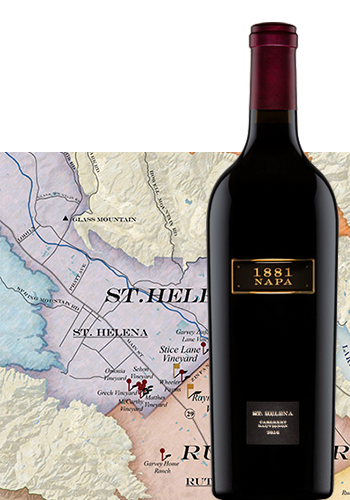

NAPA AVA - Stags Leap District
Stags Leap District is named for a Wappo Indian legend about an enormous stag that jumped off one of the area's 1,200-foot vertical basalt cliffs (known as the palisades) to avoid hunters. Stag Leap's first winery, Occidental Winery, was founded in 1878 by Terrill Grigsby, whose stature was that of "American royalty." Grigsby's father was a nephew of General William Henry Harrison and fought with him in the War of 1812. Harrison later became the ninth U.S. president. Occidental Winery is now Regusci Winery. In 1888, Horace Chace, of today's Chase-Manhattan banking empire, began construction of a grand manor house on the site of the Present Stags' Leap Winery. Over the decades, the handsome stone mansion has served not only as a private home but also as a hotel, post office, speakeasy, and a relaxation retreat for officers of the U.S. Navy. In 1964, Warren Winiarski, a former Ph.D. candidate in political philosophy at the University of Chicago, apprenticed himself to Napa Valley's Chateau Souverain to learn winemaking. Six years later, Winiarski and investors paid $120,000 for a 44-acre parcel he named Stag's Leap Wine Cellars. The winery's 1973 Cabernet Sauvignon came in first in the legendary Judgment of Paris Tasting of 1976, edging out a slew of top Bordeaux. The Stag's Leap Wine Cellars wine came from the winery's "Fay Vineyard," which had originally been planted in 1961 by home winemaker Nathan Fay. It was the first Cabernet Sauvignon in the region.
Year Established |
1989 |
Acres Planted |
1,551 |
Climate |
Moderately warm with afternoon marine winds acting as a respite to cool the warmer air radiating off the bare rocks of the Stags Leap Palisades and the surrounding hillsides. Mid-summer temperatures can reach 100 degrees F (38 degrees C), but more regularly are in the mid-90 degree F range (34 to 36 degrees C). |
Elevation & Soils |
Sea level to 400 feet (0 to 122 meters). Primarily volcanic gravel-loam soil on the valley floor; rockier hillsides. |
Leading Grapes |
Cabernet Sauvignon, Merlot, Sauvignon Blanc, Petit Sirah, Cabernet Franc |
NAPA AVA - Younvtville
In 1838, Napa Valley's first non-native settler, George Calvert Yount, settled in the area today known as Yountville. Born in North Caroline in 1794, Yount was lured west by the War of 1912 and later became a fur trapper. (The 2015 Oscar-winning film "The Revenant" about mountain man Hugh Glass used some of Yount's writings to flesh out details of the true story). Yount was eventually employed by General Mariano Guadalupe Vallejo, the "Commandant General" of the Mexican state of "Alta California" (California was owned by Mexico at the time.) Yount's first "wine" was allegedly fermented in cowhides hung from trees. To up the quality of production, Yount hired immigrant Charles Krug to make wine for him in 1860. For his services, Yount was given land grants - enormous tracks of land - throughout the Napa Valley by General Vallejo. Originally named Sebastopol, Yountville's name was changed in 1867 by the United States Postal Service after Yount's death in 1865. Once home to several rowdy barrooms and brothels, Yountville, per an old California law that stated one could not sell alcohol within 1.5 miles of a veteran's home, is almost exactly 1.5 miles from the largest veteran's home in the country (established in 1884), allowing for the bar scene there to flourish. In 1973, the French luxury company Luis Vuitton Moët Hennessy bought land in Yountville and began the first French-American sparkling wine company in the United States, Chandon USA. Although tiny, Yountville is a culinary mecca today, home to a plethora of restaurants, cafés, bakeries, tasting salons, and gourmet food shops, including Thomas Keller's Michelin-starred restaurants The French Laundry (three stars) and Bouchon (one star), Jean-Charles Boisset's JCB Village, and Michael Chiarello's Bottega.
Year Established |
1999 |
Acres Planted |
2,874 |
Climate |
Yountville has moderately warm summer temperatures influenced by cool marine winds and fog. Mid-summer peak temperatures may reach high 90s degrees F (35 degrees C), with a noticeable drop in night temperatures to the mid-50 degree F range (12 to 13 degrees C). |
Elevation & Soils |
20 to 200 feet (6 to 61 meters). Primarily gravelly silt loam with some rocky areas. |
Leading Grapes |
Cabernet Sauvignon, Merlot |
